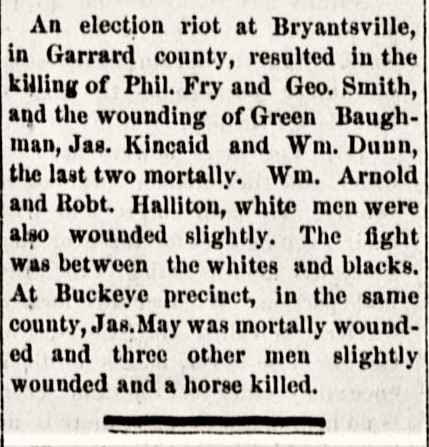

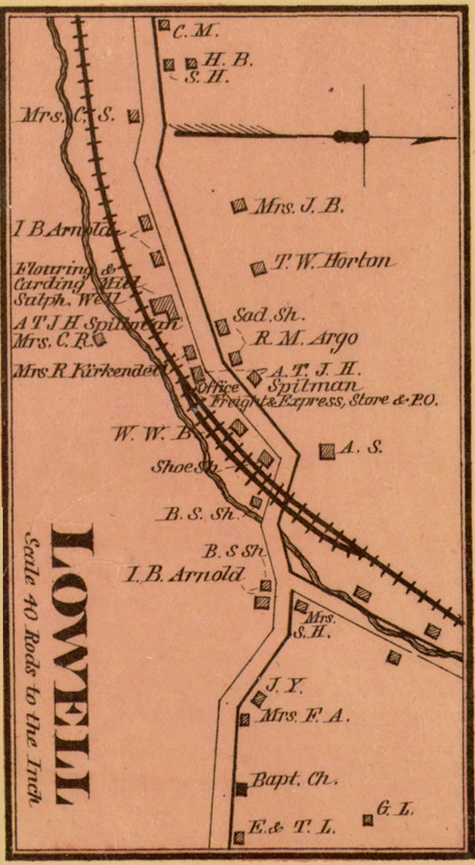
Detail from the 1879 Beers and Lanagan Land Ownership Map of Garrard and Lincoln Counties showing the village of Lowell, which was almost 60% African American in 1880
University of Wisconsin-Milwaukee Libraries
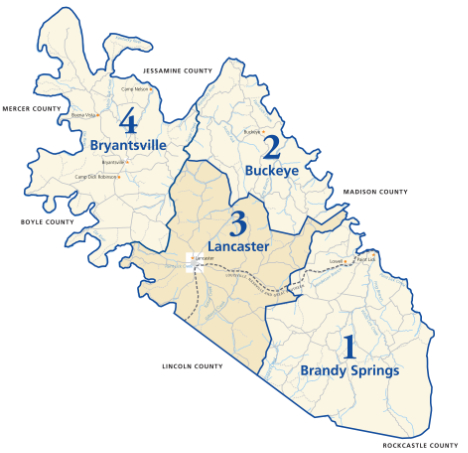
Map of Garrard County showing the four election precincts
Garrard County, 1870
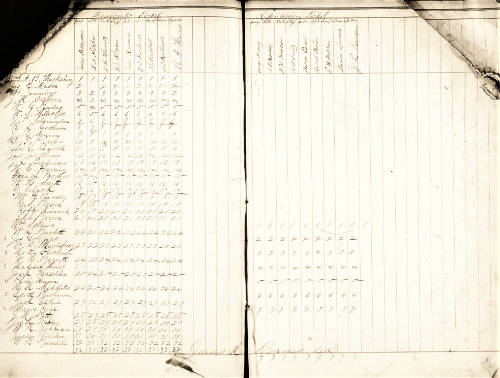
Page from the Lancaster precinct pollbook for the August 1870 county election, showing the first black voters of the day (with numbers next to their names on the left).
August 1, 1870
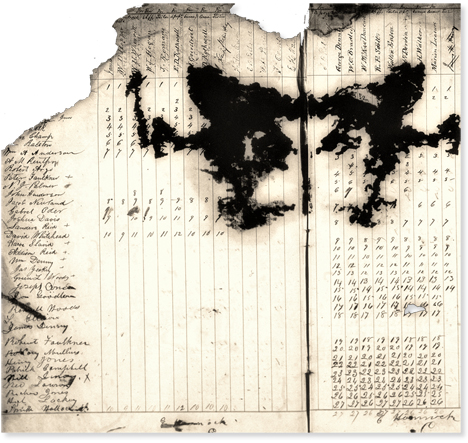
Damaged First Page from the Poll Book for the August 1870 election in Brandy Springs, showing a “+” or “x” annotation next to each African American voter’s name
August 1, 1870
A Cross-Racial Alliance
Political Leadership Ensures a Republican Majority
It would have been extremely difficult for the African American men of Garrard County, no matter how enthusiastically they expressed their political independence after the enactment of the 15th Amendment, to elect preferred candidates on their own. African American men were nowhere near a majority of the eligible electorate in the county, making up about 33% of the total population and no more than 30% of those eligible to vote. In some parts of the county, like the villages of Davistown and Lowell, African Americans were a majority of the population. However, Kentucky’s county court system provided few opportunities for local representation. Important county offices — county judge, county clerk, county attorney, and sheriff — were elected at-large. The few opportunities for African Americans in Garrard County to elect candidates in their own right were judicial officers — magistrate and constable — elected at the precinct level, as well as villages where residents chose town trustees and constables.
In the face of these barriers, African Americans in Garrard County could taste political victories for county, state and national offices only if they partnered with white voters. The black-white Republican alliance which formed in Garrard County in 1870, under the leadership of Judge George Denny Jr, provided just that partnership. The alliance was not without tensions, with African American voters largely providing the muscle for a Republican Party that, with only one contentious exception in 30 years, nominated and elected white candidates. Additionally, displays of black voting power were frequently met with violence and mayhem.
The First Election
At the first election in which African Americans could vote, George Denny Jr. and a coterie of prominent white Republicans swept the county election on the back of the African American vote. In the August 1, 1870, poll in the Lancaster precinct, held at the county courthouse, African Americans provided 70 percent of each Republican candidate’s vote in that precinct. Most African Americans voted a straight party ticket: there were only five black Democrats among Lancaster’s 256 black voters. Ninety eight percent of black voters in Lancaster voted Republican, while only 17 percent of white voters voted Republican. Every Republican candidate in the county election won because, and only because, of the black vote. Without the black vote, Denny would not have been elected County Judge and none of the other eight Republican candidates would have been elected. With the votes of African Americans, all nine were elected.
Bolstered by black turnout, the cross-racial Republican coalition triumphed, winning most county elections for the next 30 years. African American men frequently turned out at higher rates than white men. In the August 1875 gubernatorial election, estimated black turnout was significantly higher than white. In the Brandy Springs precinct in the south of the county, black turnout was 16 points higher (79% to 63%) and in the Bryantsville precinct in the north of the county, black turnout was six points higher than white (73% to 67%). In Lancaster, estimated black eligible voter turnout was 20 points higher in the August 1876 election for county law enforcement (sheriff, constable, and marshal) and, as late as the 1891 gubernatorial election, was 10 points higher.
The coalition was remarkably successful. Republicans won the county nearly 80 percent of the time in state and federal elections until the turn of the century.
Tensions in the Cross-racial Coalition
Nominating a Black Candidate
The success of the Republican coalition was not without its tensions. There were no black candidates for office in Garrard County until 1882, 12 years after the 15th Amendment came into force. Black voters were, in essence, the muscle for the election of white office holders.
Stumbling toward black officeholding produced an electoral disaster for the Republican Party of Garrard County. In the spring of 1882, the Garrard County nominating committee for the Republican Party, run by Denny and William O. Bradley (who would be elected governor in 1895), deadlocked over candidates for local office. The Committee called a “mass convention” for Saturday, May 6. In a tumultuous meeting, in which black participants outnumbered whites three to one, John Perkins, a black man, won the nomination against two white men for the office of jailer.
The office of jailor was a low-level position with a one-year term of office, but the issue of a black man nominated over white men was instantly divisive. The party leadership split: white Republican voters revolted. The turmoil over this nomination descended into violence as the August 6 election approached. Ebenezer Best, a “one of the staunchest Republicans” publicly proclaimed he would now vote Democratic. On the Sunday night before the election, Best was shot and seriously wounded as he rode past Denny’s home in Lancaster. According to a Democratic Party paper, the perpetrators were part of a “Republican camp” holed up there. Best said he would still vote Democratic.
The Democrats, for the first time in years, swept the August 1882 county election. Denny gave a “fiery” speech a few weeks later as the party assembled to nominate a candidate for the November Congressional election and “promised that Garrard should never again disappoint the faithful.” The editor of the Democratic Interior Journal paper, anticipating that the issue of black candidates for office would endlessly divide the Republican Party, gleefully proclaimed that Denny was “biting off much more than he can chew” (Semi-Weekly Interior Journal, May 9 and August 18, 1882).
The Democrats swept the November election as well. On election day, Denny, entertaining Democrats as well as Republicans at his home in Lancaster while poll book results came in, heard early news of Democratic gains, then news that Garrard might be safe for the Republicans. “Thank God” said Denny, “I still live in a Republican county.” When news came that the Democratic tide swept over Garrard, Denny was harangued to such an extent by Democrat party men that he had to leave his own house to find some quiet (Semi-Weekly Interior Journal, November 10, 1882).
A Melee in Bryantsville
At the August elections the following year, more violence broke out, this time at the Bryantsville polls. In response to a rumor that African American men were preventing white Democrats from voting, a group of armed Democrats loaded into a Jersey wagon and rode into Bryantsville, nine miles away, cheering the Democratic ticket. They arrived around 1pm, unloaded, and strode “down the middle of the pike” until they confronted three black Republicans opposite the polling station. In the melee that followed, five African American men were killed and several wounded.
The black victims hired Denny to represent them as they sought justice. In response, white men, including James H. Anderson, made death threats. Anderson, who was part of the wagonload of Democrats that headed into Bryantsville, bragged that he had “killed most of those negroes” himself and that, if Denny was part of the prosecution of those accused of the Bryantsville killings, he would kill him too. Weeks later, in a chance convergence at the center of Lancaster, Denny shot and killed Anderson, however no charges were ever brought against those who killed the black men at Bryantsville.
Denny and Black Organizers Estranged
While the relationship between Denny and African American organizers was tense after these events, the cross-racial alliance persisted under the leadership of Bradley. By 1894, Denny and African American political organizers were estranged. Time and again black political leaders threatened to run third party candidates for any office which Denny sought. Denny’s last serious political effort was a narrow loss as the Republican candidate for Congress from Kentucky’s 7th District. Perhaps the most telling measure of Denny’s fall from grace was the decision of Bradley in his successful run for governor in 1895 to distance himself from Denny to avoid alienating black voters. Denny is said to have called the black voters of Garrard a “millstone around the neck of the Republican Party;” by the 1890s, African Americans called Denny their millstone.
The cross-racial Republican Party that Denny and his band of compatriots created recovered after the disasters of the 1880s albeit without him. It returned as the dominant political voice in the county for another decade, until the adoption of the new state constitution in 1892 that ended viva voce voting and ushered in the Australian ballot and other intentionally discriminatory laws, enacted in many states to purge the electorate of African Americans and many poor white men.
Black Voter Turnout Relative to White Turnout

Select Garrard County Elections, 1870 - 1891


